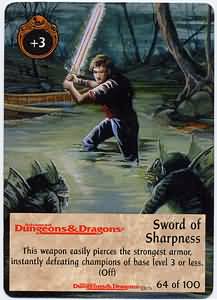Sword of Sharpness~~
[d76-00?]

Sword of Sharpness~~
[d76-00?]

|
|
|
|
|
|
|
|
|
|
|
|
|
|
|
|
|
|
|
Sword of Sharpness is a weapon which is treated as +3
or better for
purposes of who or what can be hit by it, even though it gets only
+1
bonus "to hit" and on damage inflicted.
Its power is great, however, for on
a very high "to hit" die roll as shown below it will sever an extremity
-- arm, leg, neck, tail, tentacle whatever
--
determined by random dice roll:
| Opponent is | Modified score to sever* |
| normal/armored | 19-21 |
| larger than man-sized | 20-21 |
| solid metal or stone | 21 |
* Considers only the sword's bonus of +1.
A sword of sharpness will respond to its wielder's desire with
respect to the light it sheds --
none, a 5' circle of dim illumination, a 15' light, or a 30' radius
glow equal to a light spell.
<cf. Magic Weapons, WSG>
Q: Do Strength bonuses apply when using
vorpal or sharpness swords? The
DMG seems to suggest that they don't.
A: NO, they do not, for purposes of determining
the special effects of each.
The magic which gives them their special
powers cannot be affected by
strength or magical bonuses, other than
that contained in the sword itself. HOWEVER,
if the roll is low enough NOT to
trigger the special function, then all
other bonuses are added to determine
"to hit" and damage.
(Polyhedron #2)
Q: How do you determine
which limb
is severed when the to-hit
roll indicates
that a sword of sharpness
has
severed an extremity?
A: The easiest way
would be to assign a
number or group of numbers
to each
extremity, then roll a die.
A human, for
example, has five extremities
(a head, two
arms, and two legs). Roll
1d10: 1,2 =
head; 3,4 = right arm; and
so on. A lizard
man has six extremities
(a head, four
limbs, and a tail), so you
would roll 1d6.
You could create several
complex tables
taking into account the
reach of the weapon,
the facing of the target,
and so on, but
why bother? (See the DMG,
page 166, for
details.)
(146.12)
<>